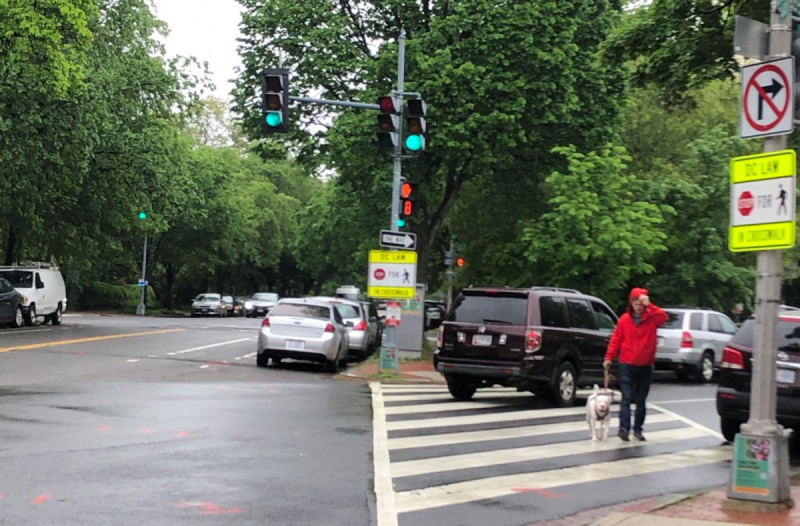Let’s bust another myth: car-friendly cities are not age-friendly cities

Right of way. Image courtesy of author.
In late February, a driver ran over my 70-year-old neighbor as she walked in a crosswalk near Eastern Market, shattering both of her legs. I’ll call my neighbor “Rose” because that’s her country of birth’s national flower, and she loves seeing them bloom as she walks around Capitol Hill.
Ten weeks later, as she tries to recuperate from the violence of the car’s impact, Rose cannot take a single step on her own. The driver also hit her friend “Lily” as they walked together, leaving Lily with a significant head injury. I saw Lily four weeks after the crash, and she struggled to remember words. “Since the accident…” she said by way of explanation, tapping her head in resignation. Lily still has to work most days, telling me she doesn’t have a choice.
When public officials propose changing the streetscape in ways that might slightly roll back the decades of investments in putting drivers first, such as installing bus or bike lanes, a common objection is that it would harm the rights and needs of seniors.
May isOlder Americans Month, a good time to examine the extent to which those needs are actually served by the drivers-first status quo and whether we need to rethink that paradigm. In 2021, I wrote thatcar-friendly cities aren’t child-friendly cities. They aren’t friendly to seniors, either.
Cars make some amenities less accessible
Rose and Lily were on their way to Eastern Market when a driver ran over them, at an intersection where drivers regularly flout pedestrian priority signs (see below), putting any pedestrian but particularly those who move more slowly at risk. Coupled with the highway-like Pennsylvania Ave SE to its south, Eastern Market’s both walkable in the sense that it’s easy to arrive at on foot, but also surrounded by risk.

A driver speeds through the intersection of North Carolina Ave and Independence Ave, northeast of Eastern Market, a few feet away from a pedestrian.
Eastern Market is the kind of place that offers lots of amenities enjoyed by seniors (much like the general public) such as the at-grade market, coffee shops, and bakeries, plus a post office around the corner.

Weekday brunch at Eastern Market. Image courtesy of author.

Local coffee house frequented by the over-65 crowd. Image courtesy of author.
访问这些设施可以让senior participation in public life possible and appealing, but that appeal is compromised when it’s surrounded by risky crossings.
Seniors should be part of the public sphere
It’s hard to look at how physically unwelcoming most public places are for older people in our country and conclude it’s a priority for them to move around and be part of public life and space. Like many American dynamics, the right to move around is largely on the individual, which is just too bad for people who lack the means or physical ability (a rare exception being Americans with Disabilities Act-mandated infrastructure, like curb ramps).
That’s a big problem. Is lack of deference to cars the cause of that problem? No.
Driving is inherently exclusive. Purchasing, maintaining, insuring and powering vehicles take a big chunk of most household budgets—I should know; I own a car—usuallymuch more than taking public transitdoes. Operating a car requires physical capabilities that not all of us possess to do so safely.
Biking and walking also aren’t accessible to all, but, unlike driving, they offer significanthealth and well-being benefitsto those, including seniors, who are able to use them to get around. It’s not just the people using these modes who benefit: when trips shift from driving to walking and biking, it has positive effects on public health, safety, air quality, and trip time for everyone else, including for seniors who do drive.
Driving, however, puts other people at risk in ways that transit, walking and biking do not, both from traffic violence and also from the externalities of air pollution.
Drivers and driver-first systems actually put seniors at greater risk than they do the general population, a fact conveniently left out of anti-bike advocates’ groundless claims of ageism. According to the American Auto Association, a 70-year-old is more than three times as likely to be killed by a driver moving at 30 miles per hour than a 30-year old is.

A graphic from aProPublicaarticle showing the changes of being killed by a car going 30 mph, also highlights that faster cars put seniors at greater risk.
The elevated risk doesn’t stop there. TheAmerican Association of Retired Personslists air pollution, closely associated with the amount of vehicular carbon emissions, as a particular health risk to older adults. A slew ofstudiestie poor air quality to conditions ranging from osteoporosis tolung diseasetodementia. Neighborhood walkability, on the other hand, may be associated withcognitive and mental health benefitsin aging.
In aremarkable report from 2017, the Milken Center for Future Aging identified 20 “best” cities for successful aging in America, highlighting transportation and convenience as one of nine criteria. The authors’ vision of age-friendly environments that “improve quality of life for all. They foster well-being and hold back age-associated decline” is hard to argue with. Transit appears several times in the report, but cars? Only with respect to warnings about cities with high numbers of crashes.
Underlying these considerations is a universal fact: Today’s adults are tomorrow’s seniors. Re-entrenching driver priority locks us in an endless cycle, in whichlack of physical activity systematically undermines healthy agingin America. If we want to do better either by ourselves—tomorrow’s seniors—or any of those who grow up after us, we have to start with building healthiercities that improve health over our entire life course.

Masked up on Metroby John Brighenti licensed underCreative Commons.
Seniors need safe and viable choices to move around in public
Seniors, as with most demographic groups, aren’t homogenous in their travel preferences. Some prefer to drive (as Alex’s grandmother did), just as Rose and Lily (and Ron’s grandmother) like walking and taking the bus. And driving isn’t always bad for seniors. The WHO’sage-friendly cities frameworkhas this to say about transportation:
方便和负担得起的公共交通是关键to ensuring a city’s elderly population is able to age actively and remain engaged with their community, with access to health and social facilities. Driving conditions and parking facilities in a city should also keep older drivers in mind.
An age-friendly transportation system, then, makes room for multiple modes and makes senior mobility—which doesn’t have to rest solely on driving—a priority. It also encourages seniors to take part in public life. While a car can facilitate access to that, it is notoriously difficult to socialize from within a personalized steel-and-glass-box.
作为we’ve designed the way we get around more and more narrowly around one option primarily, driving, we’ve made it harder and harder to use all the others. Cutting down the viable options hurts people with limitations, whether financial or physical (both issues for many seniors), more than those without them. (And if you think seniors had better drive because of Covid exposure, just bear in mind thatno evidence has been foundthat the risks on transit are higher thanany other indoor public setting–it might even be lower. Even so, Covid won’t always pose the threat that it has over the last two years).
Restoring and expanding options sometimes means that some threads from the red carpet we’ve laid out for driving for decades have to be rewoven into other modes. With some priority-setting from elected officials in welcoming seniors out of their homes, focus from the District Department of Transportation, and support from neighbors, friends, and community members, doing so can go hand in hand with the needs of seniors who are indeed car-dependent.

Crossing U Streetby Mike Maguire licensed underCreative Commons.
Breaking free of the status quo
When I say community support, I mean partly that concerned neighbors can help with things like applying for a disabled parking permit if that’s what’s needed. I also mean that if we’re sincerely worried about our older neighbors, maybe the rest of us need to drive less ourselves. Believe me, it’s better than watching a cherished older neighbor, friend, or family member suffer from traffic violence. Butdesign is what matters most, and good design relies on clear priorities.
A city in Germany that took an故意age-friendliness方式focused its efforts on providing seniors with opportunities to be active and independent, and fostering connections with their community. Nowhere in the article about that project do the words “car,” “parking”, “driving,” “drive,” or “driver” appear (“bus” does). That doesn’t mean they don’t matter. But enshrining the ability to drive and park is not an essential part of looking out for seniors’ welfare in one of the few places that has intentionally planned for their needs.
The theme of this year’s Older Americans Month is “Age My Way,” highlighting that the needs of seniors are not necessarily more monolithic than those of the general population. It’s inclusion and choices that matter. If senior mobility matters to us as a society, what’s needed is not knee-jerk reversion to cars, but a holistic view that starts with needs and plans for the options that can best serve those needs.
Seniors belong in public life and public space. Let’s create numerous ways for them–and one day the rest of us–to be there.
